Protecting a tree from mold, decay and bugs is the primary task of any owner of a wooden house or log house. This question is important if you are working with wooden products, which will later be used on the street. Homemade homemade furniture also needs protection from moisture and other negative factors.
- Oil or wax
- Pros and Cons of Oil Impregnation
- Tung oil
- Teak oil
- Tar oil
- Linseed oil
- Tinting oil
- Wood impregnation at home
- Impregnation technology
- Preliminary stage
- Smearing
- Soaking
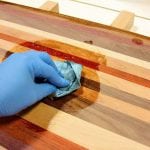
The best tool is coal oil for wood impregnation. But it is used only for impregnation of sleepers or other objects operated in harsh conditions. For independent work, more accessible and pleasantly smelling compounds are used.
to contents ↑Oil or wax
Both of these substances are used to protect wood from moisture, mold, fungus, rot and bugs. Both oil and wax have been used since time immemorial and invariably show good results. They improve the appearance of the tree and increase its strength and durability.
Impregnating oils for woodwork have high antiseptic properties, penetrate deeply into the structure of wood, making its surface elastic. They protect the tree from drying out, do not clog pores, giving the surface the opportunity to breathe, and regulate humidity. Oils for wood are harmless to humans and are considered the most environmentally friendly way to protect it along with wax.
Of the oils most often used for self-impregnation of a tree, one can note:
- tung;
- teak;
- tarry;
- flaxseed.
Some people prefer to use sunflower oil to impregnate wood. However, it gives the worst effect. The reason is polyunsaturated fatty acids: they are extremely few in sunflower.
Waxing is the oldest way to protect wooden products from moisture. Wax fills the pores of the tree and gives it a matte color. Its only negative is the lack of “breathing” in the treated wood.
to contents ↑Important! It is impractical to work with pure wax, therefore it is dissolved in vegetable oil, for example, in linseed, plus other additives (turpentine) are included in the composition. Such work is quite lengthy. Therefore, the impregnation of wood with oil compounds is considered the best option for protecting it from moisture, rot, mold.
Pros and Cons of Oil Impregnation
Oil-based wood processing has many advantages. It:
- ecological cleanliness;
- aesthetic appearance of processed products: oiled surfaces, after good polishing, acquire a matte shine, become velvety to the touch;
- ease of processing;
- material availability;
- relative cheapness;
- quick restoration of mechanical damage. It is enough to reprocess the furniture or floors / ceilings / walls, as the scratches immediately disappear.
Oil impregnation will be an ideal protection option for products from expensive / exotic woods, houses / buildings made of logs (logs), furniture that is exposed to moisture.
However, oil impregnation also has disadvantages:
- Surfaces are rather demanding in leaving. This applies to both furniture and floors, ceilings, walls.They need to be soaked every 3-4 months, and then carefully polished.
- Oiled surfaces are vulnerable to grease. The spots from it are clearly visible. Reprocessing removes them.
Tung oil
This is the oldest product used to protect internal wooden surfaces from moisture, rot and wood-boring bugs. They can be impregnated with floorboards, ceilings, wooden furniture, platbands and even utensils.
Important! Under Tsarist rule, tung oil was used to decorate especially valuable wood species, from which unique interior items were made. This is due to its amazing ability to penetrate very quickly into the surface layer of wood, revealing its texture as much as possible.
Before starting work, tung oil must be mixed. It is best to work at an air temperature of + 15 ° C. At a lower value, the composition thickens, and its consumption accordingly increases (the standard amount per square meter is 100 - 150 g). Application is done with a very thin layer of the brush. Then let the oil soak (20 minutes), take a sponge or soft rag and rub the residue into the tree along the fibers. Surplus is removed. To increase the absorbency, you can dilute the tung oil with 40 percent white spirit. The product is ready for use in a day.
to contents ↑Important! All oiled used rags are disposed of as household waste. From the hands, fat can be washed off with warm soapy water.
Teak oil
This is a universal product. It can be processed both internal wooden surfaces (floors, ceilings, decorative products, railings, stairs, etc.) and external (facades, arbors, garden furniture, decorative figures for landscape design). Ideal for processing products from oak, mahogany, beech and other valuable types of wood.
Teak oil is an environmentally friendly product. It consists of tung and linseed oil, peeled pine turpentine. It has nothing to do with the tree of the same name (teak).
Important! Never breed teak oil! Stir it well and / or shake the can well before work.
Important! The tool has worked well in damp rooms, so they can process valuable wood in the bathroom.
to contents ↑Tar oil
It is one of the strongest natural antiseptics for independent woodwork. It consists of pneumatic resin, pine turpentine and linseed oil. Turpentine improves the penetration of the composition deep into the wood, linseed oil holds, preventing it from reaching the surface. The composition is actively used for processing the bottom of boats and moorings. It is also used for external impregnation of log buildings, garden houses and garden furniture.
The properties of tar oil are similar to teak and tung. It provides excellent protection of wooden surfaces from moisture, rot and wood bugs, while giving the tree a transparent texture. The technology of work is the same as that of tung and teak oils: on 1 m2 of a well-sanded surface, only 100 - 150 ml of the product is required. To impregnate the walls of the log house, 5 to 10 liters per square meter are needed.
The impregnated surface dries up to 7 days. Drying time depends on both the quality of the wood and the surrounding conditions. When applied in one layer, the drying time is only 24 hours. Dilution is not allowed, thorough mixing is required before use!
to contents ↑Advice! Store tung, teak and tar oils in tightly-closed containers in a cool, dry place. They are not afraid of freezing and retain all their properties in cold weather.
Linseed oil
It is considered to be the best and cheapest way to protect wooden surfaces. Flaxseed oil has high waterproofing qualities and is intended for the treatment of external and internal surfaces. They can be impregnated with wooden facades, walls, ceilings, platbands, furniture and other wooden interior items, it perfectly displays the texture of wood, penetrates into the smallest cracks, preserves the wood, creating a durable water-repellent layer on its surface.
During the impregnation, linseed oil thickens under the influence of environmental factors (low temperature, oxidative processes). Actively contribute to this triglycerides contained in it - linoleic and linolenic acids.
to contents ↑Important! Flaxseed oil dries longer than all of the above - up to three weeks, depending on the number of layers. If you add tar, wax or turpentine to it, the process can be accelerated.
Tinting oil
Toning oils are impregnations based on oxidized vegetable fats that are used to emphasize the natural beauty of a tree and have protective properties. It is the use of tinting that will help prevent wood damage from exposure to such factors:
- mold, fungus;
- settlement of insects;
- getting wet and rotting;
- pollution, dusting;
- fading;
- drying;
- the appearance of cracks.
Toning is used for indoor and outdoor use, but it is especially recommended if furniture and other wooden products are used outdoors. The products are deeply absorbed, filling the pores of the tree and literally repelling water and dirt. The applied impregnation is a guarantee of a reliable strengthening of the structure of the material, as a result it becomes much stronger.
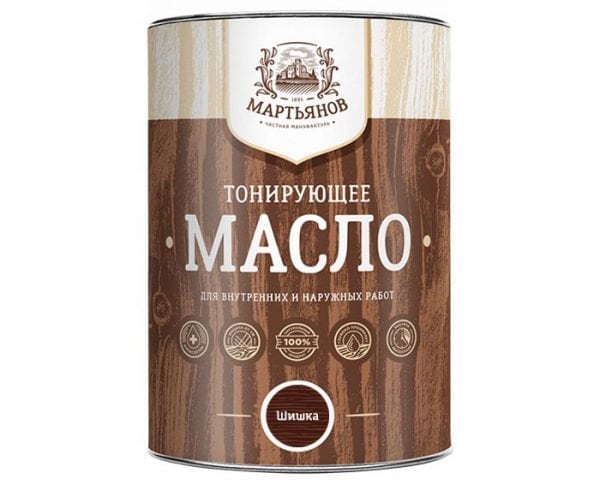
Scopes of oils are various:
- furniture;
- stairs and floors;
- parquet;
- lining;
- beams;
- exterior decoration of buildings.
Depending on the shade, the products are transparent and colored. As an example of the latter, tinting oil “Martyanov” - “Premium Pine cone” and its other varieties (“Mahogany”, “Fog”, “Nut”, etc.) can be called. The consistency of the products is even, uniform, they are easy to apply, quickly absorbed, and at the same time they are ideally combined with waxes and varnishes on wood. The advantages of all tinting can be called safety for health, the absence of an unpleasant odor, the ability to use as an independent means for wood.
to contents ↑Wood impregnation at home
Consider this process as an example of linseed oil as the cheapest and most affordable for the ordinary craftsman. To work, you need a small list of useful things:
- natural hair brush, foam sponge, soft rag, rags;
- oil, a stick for mixing it;
- building hair dryer, metal brush - to remove the old coating;
- sandpaper to bring the surface to a perfectly even state;
- a broom to remove dust from the surface;
- gloves not to get dirty.
Impregnation technology
There are many ways to oil a tree. Someone like smearing and further rubbing, someone prefers soaking. True, the second method is suitable only for small items - decorative dishes, figurines. Dishes, by the way, can be used (as a container for bread, salt / sugar, fruit), because it is completely not afraid of water.
to contents ↑
Preliminary stage
An important stage of work before impregnation will be the preliminary preparation of the external / internal surfaces. For digestion, you will need to carefully sand the dishes or figures. It is assumed that they have just been carved from wood and are not covered with anything on top. Otherwise, you will have to remove both the paint and the varnish, and this is a very dreary task.
For large areas (walls, floor, ceiling), you will have to do much more:
- Peel off old coating. This includes varnish, paint. Use for cleaning with a wire brush, spatula. If the paint does not want to be cleaned, heat it with a building hair dryer. When it bubbles up, pry off the layer with a spatula and remove.
- Sanding the surface. Use two types of sandpaper for this - large and small. Cleaning can be stopped when a smooth surface without flaws is felt at hand.
- Remove dust. Swipe it with a soft (Vietnamese) broom or use an ordinary rag. Before oil impregnation of dust on the surface should not remain.
Smearing
The easiest way to protect a tree from moisture and decay is to oil it. This is best done with a rag. But you can use a brush with natural pile. This is true for small areas (platbands).Impregnate internal / external walls, ceiling or floor with a soft cloth dampened with oil. This is done as follows:
- Stir the product and pour the part into a separate container.
- Moisten a cloth and begin to soak. Apply the composition along the fibers.
- Leave the oil for 15 to 20 minutes. Then remove the residue with a rag.
- Allow the surface to dry, then repeat the treatment.
Soaking
This method is used for small products. Pour oil into a container and place a pre-cleaned wooden product in it. The exposure time is not limited. Ideally, you need to keep a plate, a figure, the handle of a knife or a gun until air bubbles cease to stand out from the tree.
After that, take out the thing, put it on a table covered with clean paper, in an inclined state, so that excess oil drains. Then take a rag and polish. Pure linseed oil without additives dries for a long time - up to 3 weeks. This has its own plus - the depth of such impregnation is great, and the tree receives excellent protection from moisture, rot, mold. If you cannot wait to see the finished product, add beeswax to the linseed oil. This will greatly speed up the process.
Flaxseed oil / wax recipe (suitable for both exterior and interior surfaces):
- Heat oil until smoke appears.
- Pour the grated wax into it.
- Shuffle. When the wax has dissolved, pour the composition into a jar.
- To give the mixture a pleasant aroma, add a few drops of juniper oil.
The ratio of parts in oil-based formulations may vary. To get a thin layer (floor treatment), 9 to 10 parts of oil and 1 part of wax are taken. Processing with such a composition is carried out 3-4 times. Compounds based on oil and wax 3 to 1 or 4 to 1 are suitable for wall impregnation. An oil / wax ratio of 1 to 1 is acceptable for processing ceilings. The layer from it is thick, the protection against moisture penetration is maximum, but the resistance to mechanical damage is very weak. But no external influences threaten the ceiling. Therefore, a composition based on linseed oil with the addition of wax 1 to 1 is the most suitable option for it.
Wood impregnation with oil compounds is an inexpensive option for protecting it from various adverse factors. Compared with industrial antiseptics, it is cheap, high quality and completely safe for health at all stages of the work.

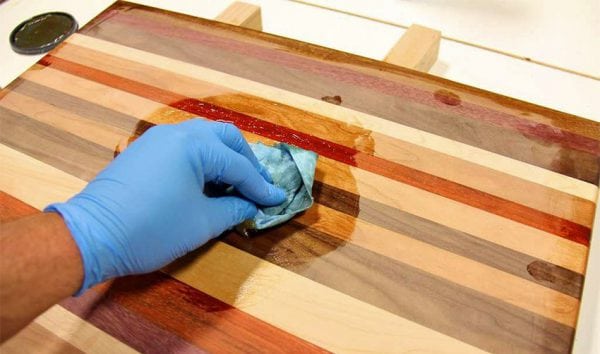
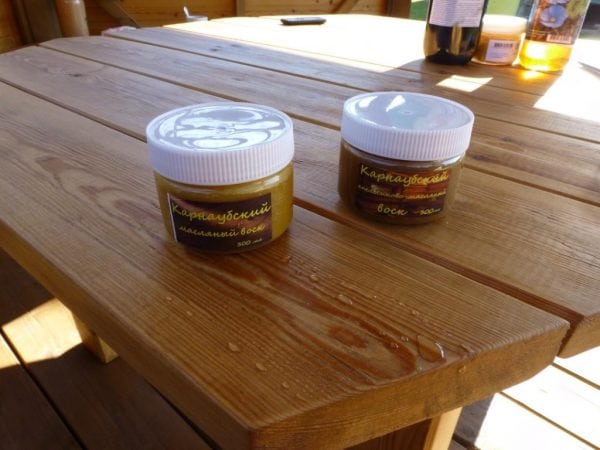
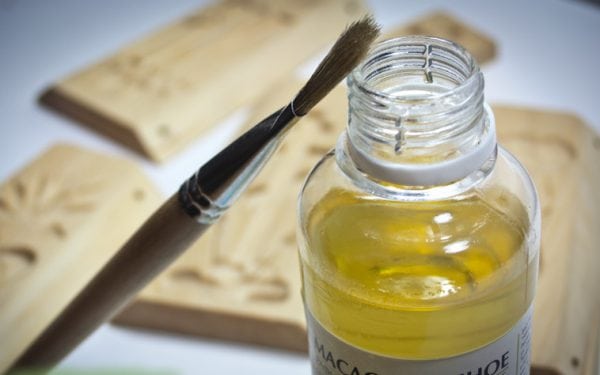
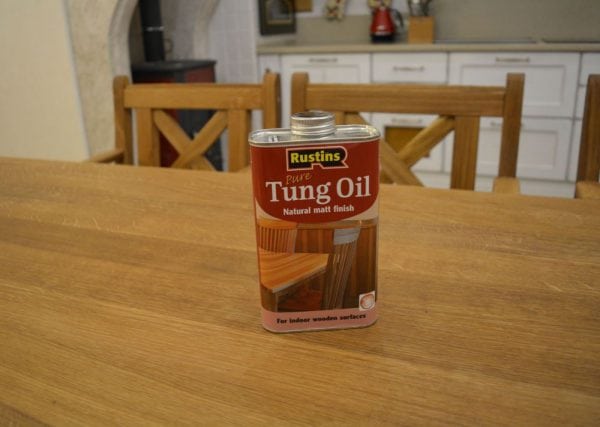
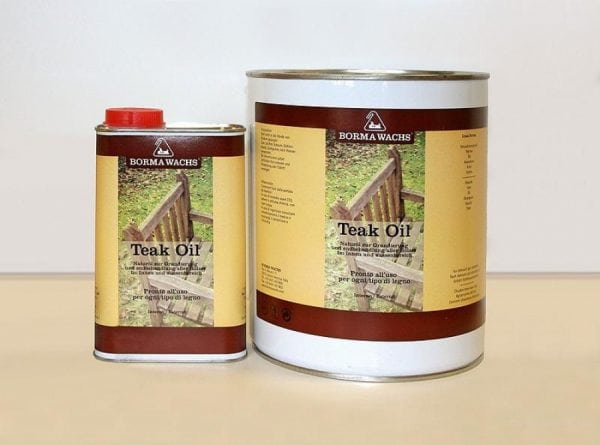
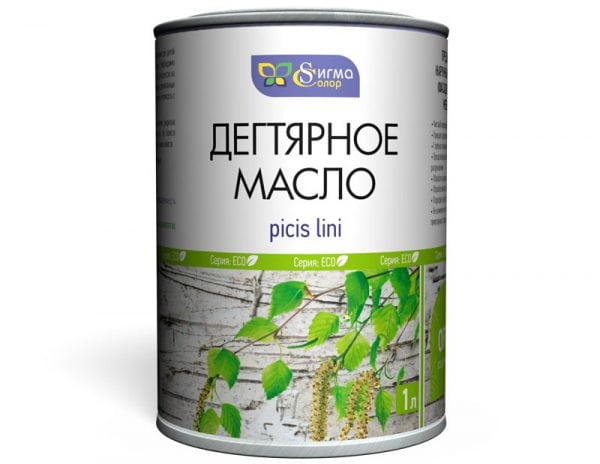
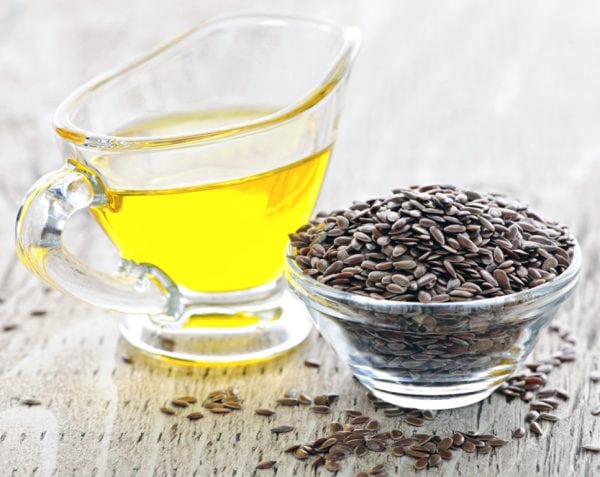
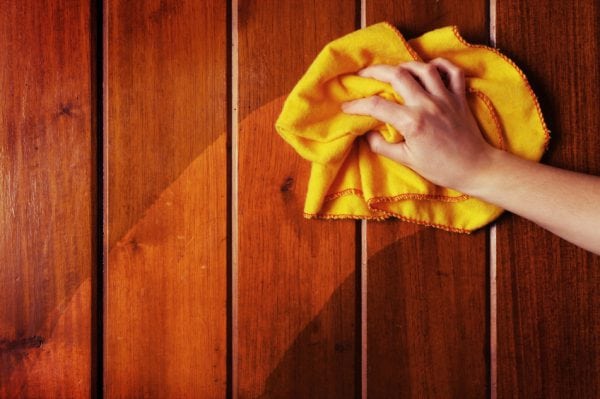
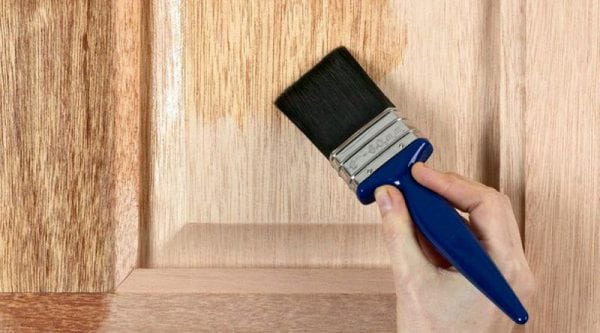




Do not try to oil the tree, only varnish. For the filling, I spread the oak table with linseed oil, for five years now it’s been a greasy, absorbing dirt, darkening and peeling off with a fingernail.
Sasha, I have been working with oils for many years. What you describe is a violation of the application technology. Oil requires certain knowledge. Oil after application must be removed from the surface, it should remain only inside. Then nothing will stick and the nail will be removed.
Treated with linseed oil stairs in three layers. (Beech stairs, oil from the pharmacy). I dried it in the sun, probably about 2 weeks. All one does not dry completely. A desiccant is nowhere to be bought. Therefore, I bought imported oil from the construction store with sicivas already. I applied it only on the front surface of the steps, on a tree soaked in linseed oil. Three days dried up, cleaned with fine emery and turned out an excellent surface. I don’t know how resistant to abrasion will be - we'll see.
to dry the oil you need 15 parts of air per 1 oil, so the wood is deeply soaked
it is impossible, but it is better to cover it with linseed oil